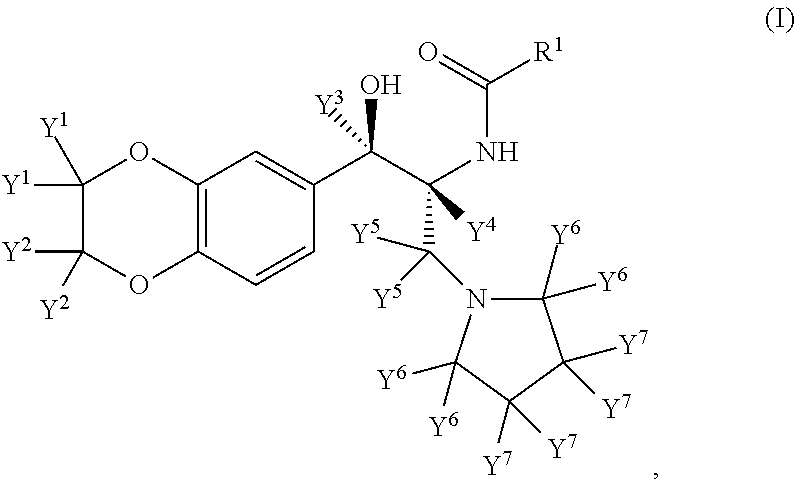Inhibitors of the enzyme udp-glucose: n-acyl-sphingosine glucosyltransferase
a technology of n-acylsphingosine and glucosyltransferase, which is applied in the direction of heterocyclic compound active ingredients, biocide, drug compositions, etc., can solve the problems of poor absorption, distribution, metabolism and/or excretion (adme) properties, and many current medicines suffer
- Summary
- Abstract
- Description
- Claims
- Application Information
AI Technical Summary
Benefits of technology
Problems solved by technology
Method used
Image
Examples
example 1
N-((1R,2R)-1-(2,3-Dihydrobenzo[b][1,4]dioxin-6-yl)-1-hydroxy-3-(pyrrolidin-1-yl)propan-2-yl)-octan-d15-amide hemi-L-tartaric acid salt (Compound 102•tartrate salt)
[0121]
Step 1. (S)-5-Phenylmorpholin-2-one (1a)
[0122]To a solution of phenyl bromoacetate (20) (25.9 g, 120.4 mmol) in acetonitrile (90 mL) was added dropwise a solution of (S)-(+)-2-amino-2-phenylethan-1-ol (21) (15.0 g, 109.5 mmol), and diisopropylethylamine (47.7 mL, 273.8 mmol) in acetonitrile (360 mL) at room temperature over 2 hours. The reaction mixture was stirred at room temperature for 16 hours, concentrated under reduced pressure at <20° C. and purified by silica gel chromatography, eluting with 0 to 100% ethyl acetate in heptanes to afford (1a) (13.3 g, 69% yield) as a beige oil, which was dissolved in benzene (66 mL) and stored at low temperature. (Caution! (1a) is unstable at elevated temperature and on silica gel for extended time period, and so, a temperature of <20-25° C. was maintained when concentrating r...
example 2
N-(1R,2R)-1-(2,3-Dihydrobenzo[b][1,4]dioxin-6-yl)-1-hydroxy-3-(pyrrolidin-1-yl-d8)propan-2-yl)octanamide hemi-L-tartaric acid salt (Compound 112•tartrate salt)
[0130]
Step 1. (2S,3R)-3-(2,3-Dihydrobenzo[b][1,4]dioxin-6-yl)-3-hydroxy-2-((2-hydroxy-1-phenylethyl)amino)-1-(pyrrolidin-1-yl-d8)propan-1-one (5b)
[0131]To a solution of compound 3a (6.16 g, 12.7 mmol) in dichloromethane (50 mL) was added pyrrolidine-2,2,3,3,4,4,5,5-d8 (4b) (4.00 g, 50.6 mmol, Cambridge Isotope, 98 atom % D) and stirred at room temperature for 16 hours. The mixture was concentrated under reduced pressure, and the resulting residue was dissolved in methanol (50 mL) and concentrated under reduced pressure (process repeated 2×) affording a yellow oil which was dissolved in mixture of methanol (50 mL) and 1M HCl (50 mL) and refluxed for 4 hours, cooled, and stirred at room temperature for 16 hours. The mixture was concentrated under reduced pressure and the resulting aqueous mixture was washed with ethyl acetate (3...
example 3
N-(1R,2R)-1-(2,3-Dihydrobenzo[b][1,4]dioxin-6-yl)-1-hydroxy-3-(pyrrolidin-1-yl-d8)propan-2-yl)octanamide-d15 hemi-L-tartaric acid salt (Compound 114•tartrate salt)
[0136]
Step 1. N-((1R,2R)-1-(2,3-Dihydrobenzo[b][1,4]dioxin-6-yl)-1-hydroxy-3-(pyrrolidin-1-yl-d8)propan-2-yl)octanamide-d15 (8c)
[0137]To a solution of 7b (0.92 g, 3.22 mmol) and diisopropylethylamine (0.56 mL, 3.22 mmol, 1 equiv) in dichloromethane (10 mL) at 0° C. was added dropwise a solution of 22b (2.57 mmol) in dichloro-methane (1 mL). The mixture was stirred at 0° C. for 2 hours and concentrated under reduced pressure. The residue was purified by reverse phase chromatography on an AnaLogix automated chromatography system, eluting with a gradient of 0 to 50% acetonitrile in water. Product fractions were pooled and evaporated in vacuo to afford 8c (0.14 g, 10% yield) as a tan oil.
Step 2. N-(1R,2R)-1-(2,3-Dihydrobenzo[b][1,4]dioxin-6-yl)-1-hydroxy-3-(pyrrolidin-1-yl-d8)propan-2-yl)octanamide-d15 hemi-L-tartaric acid sal...
PUM
| Property | Measurement | Unit |
|---|---|---|
| temperature | aaaaa | aaaaa |
| temperature | aaaaa | aaaaa |
| pH | aaaaa | aaaaa |
Abstract
Description
Claims
Application Information
 Login to View More
Login to View More - R&D
- Intellectual Property
- Life Sciences
- Materials
- Tech Scout
- Unparalleled Data Quality
- Higher Quality Content
- 60% Fewer Hallucinations
Browse by: Latest US Patents, China's latest patents, Technical Efficacy Thesaurus, Application Domain, Technology Topic, Popular Technical Reports.
© 2025 PatSnap. All rights reserved.Legal|Privacy policy|Modern Slavery Act Transparency Statement|Sitemap|About US| Contact US: help@patsnap.com



